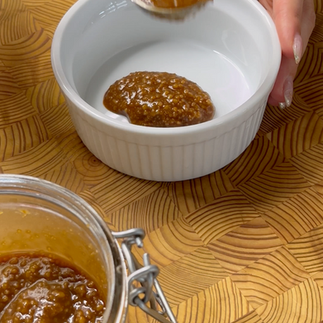What is KOJI?
- Hitomi
- Jul 25
- 3 min read
Updated: Sep 8

Koji (麹) is a traditional Japanese fermentation starter made by culturing steamed grains—typically rice, barley, or soybeans—with the mold Aspergillus oryzae. For centuries, koji has been at the heart of Japanese cuisine, used to produce staples like miso, soy sauce, sake, and amazake.
But beyond flavor, koji is a gut-health powerhouse. It breaks down proteins into amino acids and starches into natural sugars, making foods easier to digest and more nutrient-dense.
Koji produces natural enzymes that break down food molecules:
Starches → Sugars (adds gentle sweetness and aids fermentation)
Proteins → Amino Acids (creates deep umami and boosts digestibility)
Koji also contains enzymes that support better absorption of minerals and vitamins.
From tenderizing meats to acting as a sugar alternative, koji offers versatile culinary applications while improving your digestive wellness—making it an essential tool for your "cho-katsu" (腸活) journey.
The Secret Behind Japanese Fermented Foods and Better Gut Health:
If you’ve ever enjoyed a warm bowl of miso soup, a drizzle of soy sauce, or a cup of amazake, you’ve already tasted the magic of koji (麹). But did you know that this humble mold is also a superstar for gut health?
Let’s dive into the world of koji — the heart of Japanese fermentation and a gentle yet powerful ally for your digestion.
CONTENTS
Types of Koji
Koji isn't one-size-fits-all — it varies depending on the grain it's grown on:
Rice Koji (白米麹・玄米麹): The most common type, used for miso, amazake, and shio-koji.
White rice koji has a mild flavor and smooth texture.
Brown rice koji retains more fiber and nutrients for added health benefits.
Barley Koji (麦麹): Popular in Kyushu, used in barley miso and shochu. Offers a more earthy taste.
Soybean Koji (豆麹): Less common but packed with umami. Used in certain miso varieties and for experimentation at home.
Health Benefits of Koji
Koji is gentle on the body and rich in life-supporting properties:
Supports digestion through enzyme activity
Feeds beneficial gut bacteria (like a prebiotic)
Boosts immune function
Supplies amino acids, antioxidants, and B vitamins
This makes it an ideal ingredient for anyone practicing 腸活 (cho-katsu) — the Japanese term for supporting gut health through lifestyle and diet.
Where You’ll Find Koji in Foods
Koji is everywhere in traditional Japanese food. It’s the foundation of:
Sake & Amazake (sweet fermented rice drink)
Miso (fermented soybean paste)
Shio-koji (salted koji seasoning)
Shoyu-koji (soy sauce + koji blend)
Mirin (sweet cooking sake)
What Does Koji Taste Like?
Koji itself has a mildly sweet, nutty flavor with a soft, fluffy texture when fresh. When added to seasonings, it creates a deep umami that enhances savory dishes without overwhelming them.
Even better? Koji-based seasonings like shio-koji naturally tenderize and flavor foods, making your meals healthier and more delicious.
Easy Ways to Use Koji at Home
You don’t need to be a fermentation master to enjoy koji. Start with store-bought koji-based products and try:
Marinating meat or tofu with shio-koji
Adding amazake to smoothies, coffee, tea or porridge
Using miso in soups, dips, or dressings
Swapping salt or soy sauce with koji-seasoned alternatives
Koji adds complexity and gut-friendly enzymes to everyday meals, effortlessly.
Extra Koji Fun Facts
Aspergillus oryzae was declared Japan’s national fungus in 2006!
Koji produces kojic acid, known for skin-brightening and antioxidant effects.
Traditional sake breweries have dedicated “koji rooms” (麹室) to carefully grow koji under strict temperature and humidity control.
Final Thoughts: Koji as a Daily Wellness Tool
Koji isn’t just a mold — it’s a living tradition, a wellness tool, and a delicious way to care for your gut. Whether you start with a spoonful of miso, a splash of amazake, or a homemade batch of shio-koji, it’s a simple yet profound step toward better health.
Try it, taste it, and let your microbiome thank you.
Happy gut, happy life





























Comments